For someone brought up with the Beatles, it’s difficult to understand the attraction for teenagers of what came immediately before the Fab Four transformed pop music for ever. Here, for instance, is the back page Film Review promo for Beat Girl,  a movie released in 1960 that purported to show ‘ squares ‘ what their ‘beatnik’ teenage sons and daughters were getting up to behind their backs. Starring the pop singer Adam Faith ( his film debut at the age of 18 ), horror star Christopher Lee, a young Oliver Reed and the fifteen year old bilingual starlet Gillian Hills, it was also the debut of John Barry, who went on to forge a glittering career in film music.
a movie released in 1960 that purported to show ‘ squares ‘ what their ‘beatnik’ teenage sons and daughters were getting up to behind their backs. Starring the pop singer Adam Faith ( his film debut at the age of 18 ), horror star Christopher Lee, a young Oliver Reed and the fifteen year old bilingual starlet Gillian Hills, it was also the debut of John Barry, who went on to forge a glittering career in film music.
In 1960, most pop music fans were more interested in how teen idol Faith would cut it as an actor, than they were seeing ‘ the second Bardot ‘, as Roger Vadim hyped the fifteen year Hills, but looking back, it is odd that latter’s acting career never took off. Here was an actress, whose striking blonde beauty and obvious acting talent should have propelled her to greater things. In ‘Beat Girl’ Hills plays the ‘ bad girl ‘ Jennifer, the sulky-looking beatnik, who rejects the values of her respectable parents and lives for the kicks she gets out of dancing in night clubs and hanging out in milk bars. In the opening scenes of the film she is a pouting, free-spirited presence as she descends the stairs to the basement dance floor, where, seemingly oblivious to everything and everyone around her, she begins a freestyle dance routine. On her website ( which is worth a visit ) Hills describes the dance thus: ‘ my brain flipped, my feet followed and I was off’. As for her role as Jennifer, she saw it as a protest at her treatment by her Lycee in Paris, who expelled her for taking on a debut role in Vadim’s ‘Les Liaisons Dangereux ‘.
‘I could vent my frustration, my disgust, the helplessness and despair, and the anger at what had happened to my life in the recent months.’
‘Beat Girl’ proved popular in Britain, but was banned in France. However, this did not prevent Hills from taking roles in a number of French films in the early sixties and from recording pop songs in French, including the annoyingly catchy ‘ Zou Bisou Bisou’ (1961), which was later used in ‘Mad Men’. But in Britain the film roles were small. She was a brunette in the cultish ‘Blow Up ‘(1966) and in ‘A Clockwork Orange’ she had a cameo. She also appeared occasionally on British TV.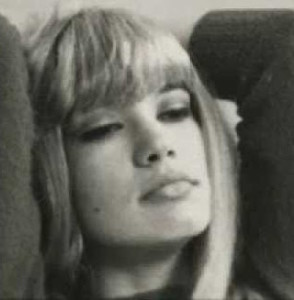
In 1975 Hills decided to stop making films and left for New York City to try her luck as a book and magazine illustrator. Judging from the artwork on her website, she appears to have genuine artistic talent too! At 72, Hills now lives in England with her husband Stewart Young, manager of AC/DC and Cyndi Lauper, among other artistes. [R.M.Healey]
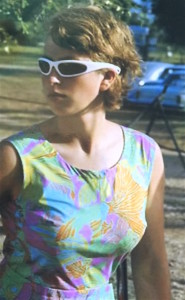 Bought at eBay for the price of a latte (and muffin) -these 3 photos purporting to be of a British royal – Anne, Princess Royal. The left and right photos are indubitably her, the middle photo (printed on Fujifilm Crystal
Bought at eBay for the price of a latte (and muffin) -these 3 photos purporting to be of a British royal – Anne, Princess Royal. The left and right photos are indubitably her, the middle photo (printed on Fujifilm Crystal



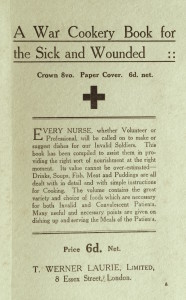
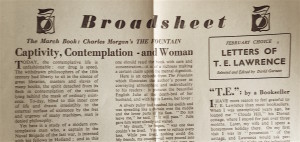 Found among the books in the working library of the actor Peter O’Toole (1932 – 2013) his copy of Letters of T.E. Lawrence (Readers Union, 1941.) O’Toole had surprisingly few books on or by Lawrence considering that this was probably his greatest role and the film that made him an international star. In the Reader’s Union edition was loosely inserted a one page wartime broadsheet keeping members of the book club informed about new publications. It was from an address at Wray Common, Reigate. This broadsheet / flier was dated February 1941and has a good piece (“T.E.”) on Lawrence by his friend and bookseller K.W. Marshall.
Found among the books in the working library of the actor Peter O’Toole (1932 – 2013) his copy of Letters of T.E. Lawrence (Readers Union, 1941.) O’Toole had surprisingly few books on or by Lawrence considering that this was probably his greatest role and the film that made him an international star. In the Reader’s Union edition was loosely inserted a one page wartime broadsheet keeping members of the book club informed about new publications. It was from an address at Wray Common, Reigate. This broadsheet / flier was dated February 1941and has a good piece (“T.E.”) on Lawrence by his friend and bookseller K.W. Marshall.
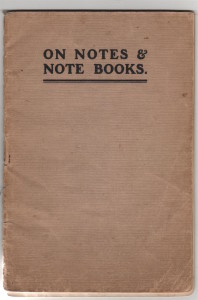 Now we are in the Digital Age, when as much data as we like can be stored in a note-book sized device made of plastic and metal, note-taking as a aid to memory is less important. As recent as fifteen years ago if we needed to record the gist of books, articles etc., we resorted to a note book made of paper and card which had to be small enough to be carried around in a pocket. In practice what we tended to do, however, was to write too much in too big a hand than was appropriate, thus making our notebook less efficient as a means of storing an accumulation of facts and opinions.
Now we are in the Digital Age, when as much data as we like can be stored in a note-book sized device made of plastic and metal, note-taking as a aid to memory is less important. As recent as fifteen years ago if we needed to record the gist of books, articles etc., we resorted to a note book made of paper and card which had to be small enough to be carried around in a pocket. In practice what we tended to do, however, was to write too much in too big a hand than was appropriate, thus making our notebook less efficient as a means of storing an accumulation of facts and opinions.
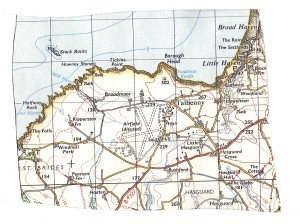
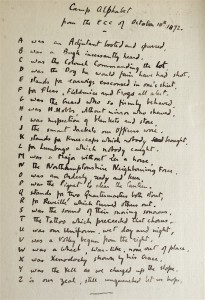 Found in Herbert Kynaston. A Memoir. (Macmillan, 1912) an acrostic for a bazaar to raise money for a home for ‘Friendless Girls’ (below). The book has the ownership signature of F.E. Balfour (1922). This is almost certainly
Found in Herbert Kynaston. A Memoir. (Macmillan, 1912) an acrostic for a bazaar to raise money for a home for ‘Friendless Girls’ (below). The book has the ownership signature of F.E. Balfour (1922). This is almost certainly 

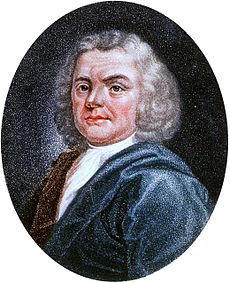

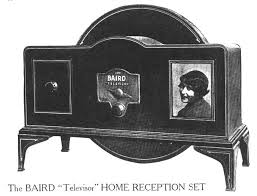 Published in the monthly miscellany Medley for September 1935 is this winning prediction from a competition run by The Manchester Guardian. It looks forward to what life might be like in 1950.
Published in the monthly miscellany Medley for September 1935 is this winning prediction from a competition run by The Manchester Guardian. It looks forward to what life might be like in 1950.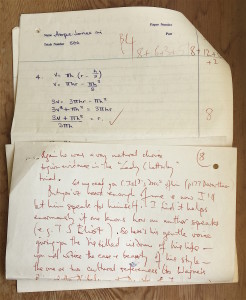 Found among the papers of the mathematician
Found among the papers of the mathematician 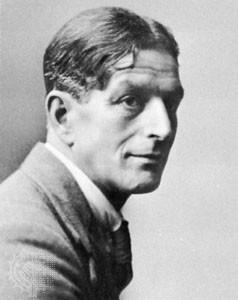
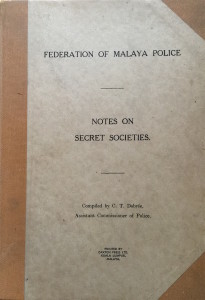
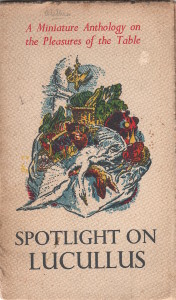
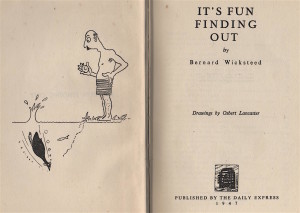
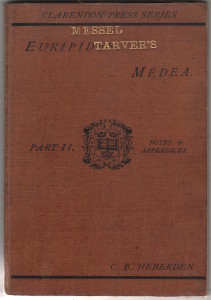 Found in a box of old text books (Zinn collection) is this copy of part two of C. B. Heberden’s edition of Euripedes’ Medea ( notes and appendices) published by the Clarendon Press in 1886.Stamped in gold lettering on the light brown cover of this distinctly dull-looking school text book are the words MESSEL/TARVERS. Inscribed in pencil on the fly-leaf we find ‘ L.Messel/Tarvers ‘, which suggests that it belonged at one time to Leonard Charles Rudolph Messel ( 1872 – 1953), father of the famous stage designer Oliver Messel. Beneath the inscription are two pencil and ink drawings—one of a veiled lady in Victorian dress, the other a small profile of a man’s head.
Found in a box of old text books (Zinn collection) is this copy of part two of C. B. Heberden’s edition of Euripedes’ Medea ( notes and appendices) published by the Clarendon Press in 1886.Stamped in gold lettering on the light brown cover of this distinctly dull-looking school text book are the words MESSEL/TARVERS. Inscribed in pencil on the fly-leaf we find ‘ L.Messel/Tarvers ‘, which suggests that it belonged at one time to Leonard Charles Rudolph Messel ( 1872 – 1953), father of the famous stage designer Oliver Messel. Beneath the inscription are two pencil and ink drawings—one of a veiled lady in Victorian dress, the other a small profile of a man’s head.